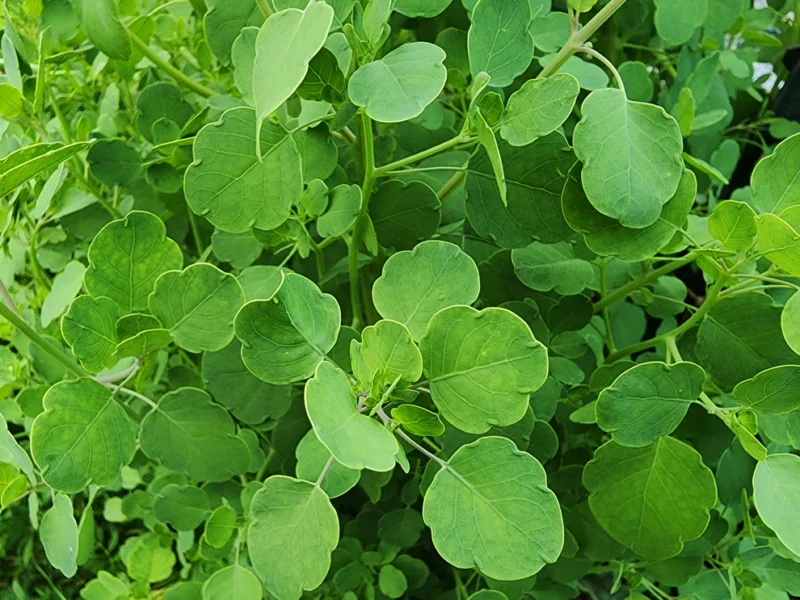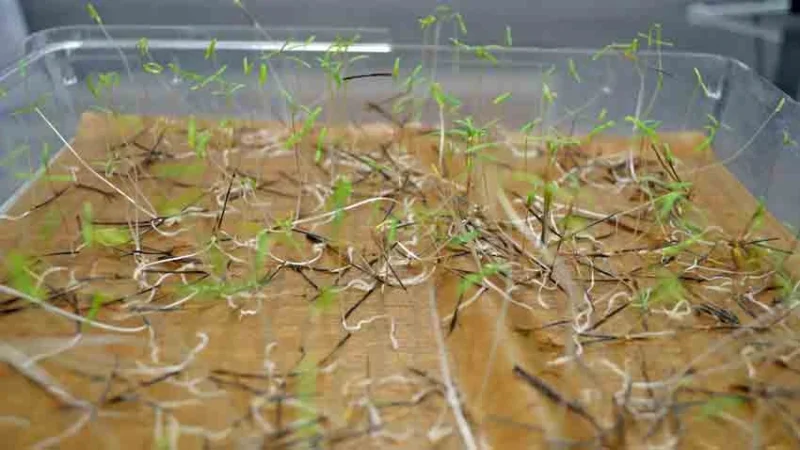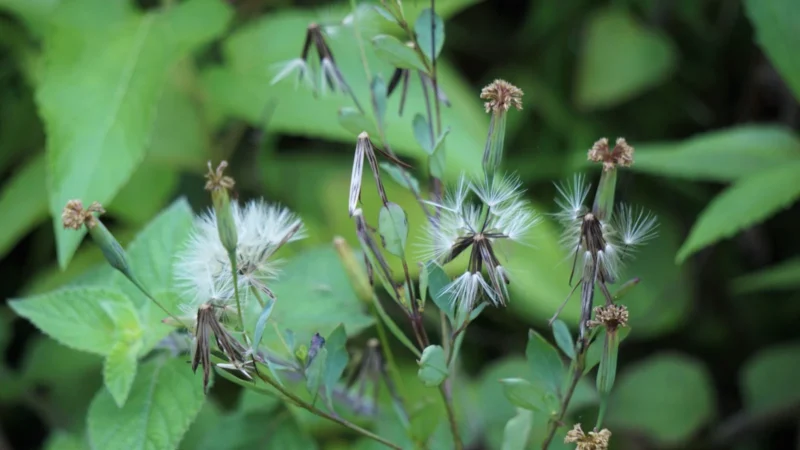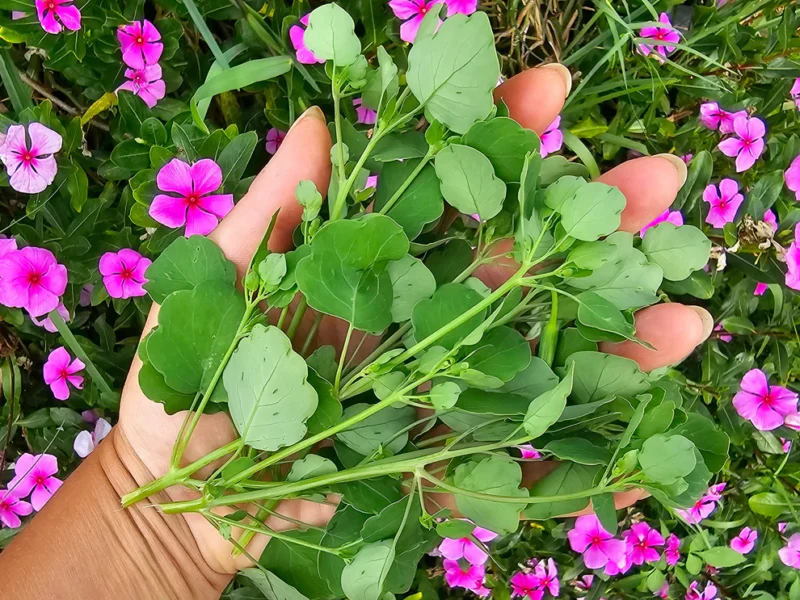Are you struggling to grow fresh herbs in hot weather? Tired of cilantro bolting too fast? If so, you’ll love papalo, a heat-tolerant herb that thrives where cilantro fails.
Papalo (Porophyllum ruderale) is a flavorful Mexican herb often used in tacos, salsas, and traditional Latin American dishes. Unlike cilantro, it loves the heat, making it perfect for summer gardens. But here’s the catch—papalo seeds need the right conditions to germinate and grow successfully.
In this guide, I’ll walk you through how to grow papalo from seeds, from germination to harvest, so you can enjoy this bold-flavored herb right in your backyard!
Read more: Discover How to Grow Papalo—A Unique Mexican Herb

Why Grow Papalo from Seeds?
If you’ve ever looked for papalo at the grocery store, you probably know how hard it is to find. That’s why growing your own is the best way to enjoy this unique herb!
- Thrives in Heat – Unlike cilantro, papalo doesn’t bolt in hot weather, making it a great option for summer gardens.
- Bold, Unique Flavor – Imagine a mix of cilantro, arugula, and citrus with a slight peppery kick. If you enjoy strong, fresh flavors, papalo is worth growing.
- Low Maintenance – This hardy herb requires minimal care and naturally repels many garden pests, making it a hassle-free addition to your garden.
- Attracts Pollinators – Bees and butterflies love papalo’s small flowers, which can help boost pollination in your garden.
- Self-Seeding – Once established, papalo often reseeds itself, meaning you may get new plants year after year without replanting.
Read more: Top 5 Reasons to Grow Papalo at Home: A Must-Have Herb for Your Garden
Whether you’re a home gardener looking for an easy-to-grow herb, a chef wanting to experiment with bold flavors, or simply curious about rare plants, growing papalo from seeds is a rewarding experience.
Step 1: Choosing the Right Papalo Seeds
When starting your papalo garden, selecting high-quality seeds is the first and most important step. Not all papalo seeds have the same viability, and choosing the right ones can make a big difference in how well they germinate. To ensure success, it’s best to purchase seeds from a trusted supplier that specializes in heirloom or organic varieties. Look for fresh seeds, as papalo tends to have a lower germination rate compared to other herbs, and older seeds may struggle to sprout.
Step 2: Best Conditions for Germinating Papalo Seeds
Papalo seeds require specific conditions to germinate successfully, so setting up the right environment is key. Unlike some other herbs, papalo is a light-dependent germinator, meaning it needs exposure to light in order to sprout. To give your seeds the best chance, plant them on the surface of the soil rather than burying them too deep.
For optimal germination, maintain a warm temperature range between 75-85°F (24-29°C) and choose well-draining, sandy, nutrient-rich soil to prevent waterlogging. Papalo thrives in full sun or partial shade, requiring at least six hours of direct sunlight daily. Keeping the humidity levels balanced is also crucial—while the soil should stay moist, it should never be overly saturated to avoid rot.
How Long Do Papalo Seeds Take to Germinate?
Papalo seeds are not the quickest to sprout, typically taking anywhere from 10 to 21 days to germinate. Patience is essential, but the reward is well worth the wait!

Germination Tips for Faster Growth
- Soak seeds in warm water for 12-24 hours before planting to help soften the seed coat and speed up germination.
- If planting outdoors, wait until nighttime temperatures remain above 60°F (16°C) to ensure warmth for healthy seedling development.
- To maintain consistent moisture, consider using a humidity dome or plastic wrap over seed trays, which helps create a stable, humid environment for germination.
Step 3: Planting Papalo Seeds
Once you have your seeds and the right growing conditions, it’s time to plant! Papalo is best grown outdoors in warm weather, but if you live in a colder climate, starting indoors can give your plants a strong head start.
Outdoor Planting (Recommended)
Papalo thrives in warm, sunny locations, making outdoor planting the best option for healthy growth. Choose a spot that receives at least six hours of direct sunlight per day. Since papalo seeds need light to germinate, sprinkle them directly on top of the soil rather than burying them. Lightly mist the soil to keep it damp but not soggy. Once the seedlings reach about two inches tall, thin them out, leaving 12-18 inches between each plant to allow proper airflow and growth.
Indoor Planting (For Colder Climates)
If you’re in a region with shorter growing seasons or unpredictable spring weather, starting papalo indoors can give your plants a better chance. Use seed-starting trays filled with organic potting mix and place them in a bright, sunny location or under grow lights for at least 6-8 hours per day. Once the seedlings are strong enough and the risk of frost has passed, carefully transplant them outdoors, ensuring they have enough space to flourish.
Companion Planting with Papalo
Papalo not only grows well on its own but also makes a great companion plant for certain crops:
- Tomatoes – Enhances flavor and helps deter pests.
- Peppers – Thrives in similar growing conditions.
- Basil & Oregano – Complements papalo with aromatic, pest-repelling properties.
- Pollinator-friendly flowers like marigolds and nasturtiums – Attract beneficial insects and add biodiversity to your garden.

Step 4: Caring for Papalo Plants
Papalo is a hardy, low-maintenance herb, but a little care goes a long way in keeping your plants healthy and productive. With the right balance of water, nutrients, and pruning, your papalo will thrive throughout the growing season.
Watering
Papalo naturally prefers drier conditions, so it doesn’t need frequent watering. In most climates, watering once a week is sufficient, especially in dry or hot weather. Avoid overwatering, as soggy soil can lead to root rot. If you notice the leaves starting to wilt, increase watering slightly, but always allow the soil to dry out between waterings.
Fertilizing
This herb doesn’t require much feeding, making it an easy addition to any garden. To support healthy growth, apply compost or organic matter every 4-6 weeks. If the leaves start looking pale, a light application of a balanced organic fertilizer, such as fish emulsion, can help restore their vibrant green color.
Pruning and Harvesting
Papalo can be harvested once the plant reaches about 12 inches tall. To encourage a bushier and more productive plant, regularly pinch off leaves rather than cutting large sections at once. Avoid harvesting more than one-third of the plant at a time, as this can stress the plant and slow its growth.
For those looking to extend their harvest, allow some plants to flower and set seed. Not only will this attract pollinators like bees and butterflies, but it will also allow papalo to reseed naturally, providing a fresh crop for the next growing season.

Step 5: Harvesting and Storing Papalo
Papalo is best enjoyed fresh, as its bold, citrusy flavor doesn’t preserve well. However, if you want to store it for later use, there are a few methods that can help retain some of its essence.
- Short-Term Storage: Place freshly cut papalo leaves in a jar of water, similar to fresh herbs like basil or cilantro. Keep the jar on your kitchen counter or in the fridge to extend freshness for a few days.
- Long-Term Storage: Drying papalo leaves is an option, but be aware that this process significantly reduces its flavor. If you choose to dry it, store the leaves in an airtight container away from light and moisture.
- Freezing: For a better way to preserve its taste, chop fresh leaves and freeze them in ice cube trays with a little water. These frozen cubes can be added directly to soups, stews, or sauces for a hint of papalo’s distinctive flavor.
Common Problems When Growing Papalo
Although papalo is a hardy and low-maintenance herb, a few issues may arise:
- Seeds not germinating? Papalo seeds require light and warmth to sprout. Make sure they are not buried too deep and are kept at the right temperature.
- Leaves turning yellow? Overwatering is a common cause. Let the soil dry out slightly between waterings.
- Leggy plants? If your papalo plants are tall and spindly, they likely need more sunlight to encourage compact, healthy growth.
- Pests? While papalo is naturally pest-resistant, aphids may occasionally appear. If needed, spray the plant with neem oil or rinse the affected leaves with water.
FAQs About Growing Papalo from Seeds
1. Can papalo be grown in pots?
Yes! Papalo grows well in containers as long as you use a deep pot with well-draining soil and place it in a sunny location.
2. How long does papalo take to grow?
Papalo reaches full maturity in about 6-8 weeks after germination.
3. Is papalo a perennial or an annual?
Papalo is an annual, meaning it completes its life cycle in one season. However, if allowed to flower, it self-seeds, often coming back the following year.
4. Can I grow papalo indoors year-round?
Yes, papalo can be grown indoors as long as it has warm temperatures and sufficient light. Using grow lights can help maintain healthy growth throughout the year.
Papalo is a fantastic alternative to cilantro, especially if you struggle with hot weather gardening. By following these step-by-step planting and care tips, you’ll be harvesting fresh papalo in no time!
Ready to try it? Grab some papalo seeds today and start your herb garden!
